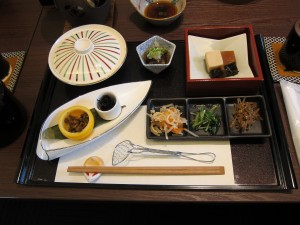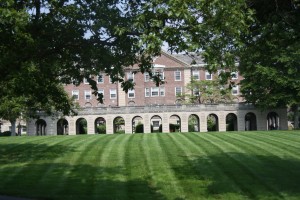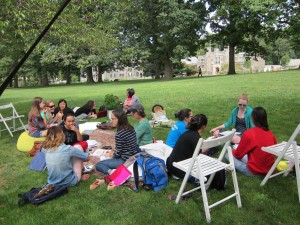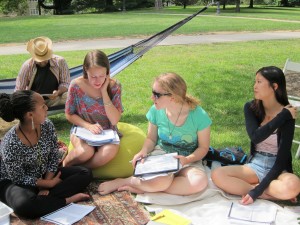- Meditation instruction at Shunko-in
- Thomas Kirchener

Our day began early again, at 5:30 am for those who walked up to Chion-in for the morning services. We packed up, put our luggage on the bus and headed to Ryoan-ji, perhaps the most iconic of the karesansui, the dry Japanese Zen gardens.
These dry gardens were often constructed for night meditations in front of the abbot’s quarters, the purpose of the white stones is to reflect moonlight. The garden at Ryoan-ji in the bright sunshine and heat of a Kyoto autumn day is a bit of a different space than at night, I suspect. And the rich mix of tourists, from Japanese school children here on field trips to couples with tour guides, and us, makes it far less still and silent than it would be “in use.”
The school children on field trips to these places have assignments from their English teachers to practice their English, generally with some prompts for questions to ask: Where are you from? Why are you here? What is most important to you? Our students enjoyed practicing their Japanese in return. They got more practice in reading Japanese as they tried to negotiate the vending machines to find something cool to drink.
Daitoko-ji is a complex of Rinzai Zen monasteries on the edge of Kyoto. We visited two of the cloisters within the monastery: Daisen-in and Zuiho-in. Both have beautiful dry gardens, though on some level these are less abstract than the one at Ryoan-ji. You aren’t allowed to photograph the gardens at Daisen-in, so I had to stick to postcards. The garden wraps around the dojo, a stream that eventually opens into a garden that is just groomed white rocks, with two cones, the better to reflect the moonlight in the garden.
From there we went to Zuiho-in, which has to my mind the most beautiful of all the dry gardens I have seen. The large garden is meant to represent a heavy sea with the sand all piled up to represent high waves. It’s focussing on one level, despite the clear chaos you can sense underlying the stillness. It reminds me of Marty Laird’s comment in Into the Silent Land that contemplation isn’t “snorting lines of euphoric peace” but a particular way of sitting with chaos.
A gallery of images from the trip so far.
We got up a bit after 5:00 am, to walk up to Choin-in up the hill from where we are staying for morning services. It was a rich sound scape, the thunk as we kept the beat for the procession on gourds, the chant, the bells, the sharp clack-clack of the wood blocks, the chirping of the nightingale floor as we moved from one space to another, the ravens cawing in the pre-dawn stillness — and the roar of the motorcycle patrolling the grounds. 
 We had a beautiful breakfast at the temple where we are staying. Little dishes of salty and savory tastes, miso soup and rice. And of course, tea.
We had a beautiful breakfast at the temple where we are staying. Little dishes of salty and savory tastes, miso soup and rice. And of course, tea.
From there we went to Kiyumizudera, a temple built next to a beautiful spring and with an amazing view of Kyoto. The streets are crowded with tourists and students, and lots of little shops. It was hot, so the water (mizu) was incredibly refreshing and the sample of cold yuzu honey (yuzu mitsu) drink was amazing. We practiced the ritual of washing your hands and rinsing your mouth at various spots. In my course we have been discussing the body and prayer/meditation. What are the connections between mind and body and the transcendent in different traditions? How do we mark boundaries between dedicated contemplative time and daily life?
We walked through Tainaimeguri – pilgrimage through the womb, a short descent beneath a hall in complete darkness. We’ve talked about James Turrell’s work in my class, about the ways in which light and darkness can be manipulated to change the texture – the set and setting – of a contemplation.
We then went to Honen-in, where we walked through a beautiful moss garden, with many water features and a much quieter spot than Kiyumizudera.
From there we walked up to Ginkakuji, the Silver Pavilion. We walked up and above the temple precincts, looking down on the gardens below. Each view elicits a different reaction.
 We gathered at Pembroke Arch at 3:45 in the morning. I watched as groups of students materialized out of the mist, carrying just a single bag. We had 24 hours of travel in front of us, two bus rides, two plane rides.
We gathered at Pembroke Arch at 3:45 in the morning. I watched as groups of students materialized out of the mist, carrying just a single bag. We had 24 hours of travel in front of us, two bus rides, two plane rides.
We are now tucked away just below Chion-in in Kyoto. Dinner was at a small Japanese place, leave your shoes at the door, sit on a cushion on the tatami. Then it was a quick walk back, and a chance to try a Japanese bath. Now we are all looking forward to sleeping horizontally, and (at least some of us) then getting up at dawn again to walk up for a morning ceremony on the temple up the hill. Konbawa!
 What does it mean to be mindful, and can we measure it? In Psychology of Mindfulness, we took the Five Facet Mindfulness Questionnaire (FFMQ – an online version can be found here) this week. The five facets are: observing, describing, non-judging of one’s inner experiences, non-reactivity, and awareness.
What does it mean to be mindful, and can we measure it? In Psychology of Mindfulness, we took the Five Facet Mindfulness Questionnaire (FFMQ – an online version can be found here) this week. The five facets are: observing, describing, non-judging of one’s inner experiences, non-reactivity, and awareness.
Along the same lines in the class on contemplation in the West, we are considering what constitutes elected silence. Is silence a necessary pre-condition for contemplation? We have been reading the 4th desert fathers and mothers, including Abba Moses who tells a supplicant “sit in your cell and your cell will teach you everything;” while Amma Syncletica suggests exterior location isn’t the issue, but the interior landscape is: “It is possible to be a solitary in one’s mind while living in a crowd; and it is possible for those who are solitaries to live in the crowd of their own thoughts.”
We are off to mindfully explore silence at the Jesuit Center, a retreat center located about 60 miles northwest of Bryn Mawr, on the grounds of an old Jesuit novitiate. We will spend parts of each day in silence, seeing if we can grasp what is so alluring about silence that for centuries people have left everything behind to seek it. When we return, we will be reading some narratives of silence.

 This week in the course on contemplation in the Western tradition we are reading excerpts from Gaston Bachelard’s Poetics of Space. What is the connection between the spaces we inhabit and our minds? our souls? How can we read what a space has to tell us? Do spaces have memories? Subtexts? Bachelard is developing a frame for thinking about such questions.
This week in the course on contemplation in the Western tradition we are reading excerpts from Gaston Bachelard’s Poetics of Space. What is the connection between the spaces we inhabit and our minds? our souls? How can we read what a space has to tell us? Do spaces have memories? Subtexts? Bachelard is developing a frame for thinking about such questions.
Class moved outside, testing the ways in which the space shaped our conversation. This outdoor space was bounded subtly by rugs and chairs, no hard edges.
Later this week, we are off to read a quite different space, a silent monastic experience.
It seems like just yesterday I was shelving the books I’d used for this course and moving the pointers to the folders off my favorites list on my computer. The monastic rule of St. Benedict suggests that we are always beginning again. Another day, another round of psalms, another academic year.
As part of Bryn Mawr’s 360 program I’m once again teaching a course on the history of contemplation and mindfulness in the Western tradition in collaboration with two colleagues, Marc Schulz in psychology and Hank Glassman (from Haverford). The three courses each have their own structure, but intertwine through shared readings and shared experiences, including field trips to a silent retreat house, Buddhist monasteries in Japan and MBSR (mindfulness based stress reduction) training.
We drove back to Osaka from Kamikatsu, with a stop in Tokushima for lunch and to run a couple of last minute errands. After the quiet of Kamikatsu, particularly of Nakamura’s hermitage, many of us found even Tokushima to be wildly overwhelming. In the spring, I remember finding Tokyo to be tough going after Koya and Kamikatsu, and how grateful I was for lunch in a pocket park on top of a department store.
We saw the famous whirlpool in the Naruta straits, it sits almost directly under the bridge. The last part of the drive was on an elevated highway along the edge of the water, though the ports. We swooped up and over more than a dozen elegant bridges. Each different than the rest, some bright red, like the gates into the temples, others looking like they had been beamed in from Gene Roddenberry’s future, spare, ultramodern spans of a grey so pale they were nearly white. It felt like we were flying in from one world, to land in another.
We tucked the last few things into our bags, then gathered in the lobby for the shuttle to Kansai airport. As I write this we are at 37000 feet, above Canada, three hours from landing and maybe 7 hours from home. Swooping back to our world…
Last night was the peak of the Draconids, a meteor shower that appears to emanate from the constellation Draco, the dragon. We used an app on my iPad to locate it in the sky, but there were clouds and a nearly full moon just before we went to bed. The peaks was to be at about 3 to 4 in the morning, and I promised to set my alarm to check then and rouse the crew if it turned out to be good viewing. At about 3:15 I heard the pitter-patter of little feet (or more precisely the shuffle thump of slippers above me, and the sliding of shoji in the hall), and got up to find a half dozen of us, along with our host at Yama no gakko,Taue-san. The sky was crystal clear, but alas, there were very few meteors to be seen (unlike the fiery skies of 1998).
After yesterday’s exploration of the cave with the dragon, it was an apt event to be in Japan for.